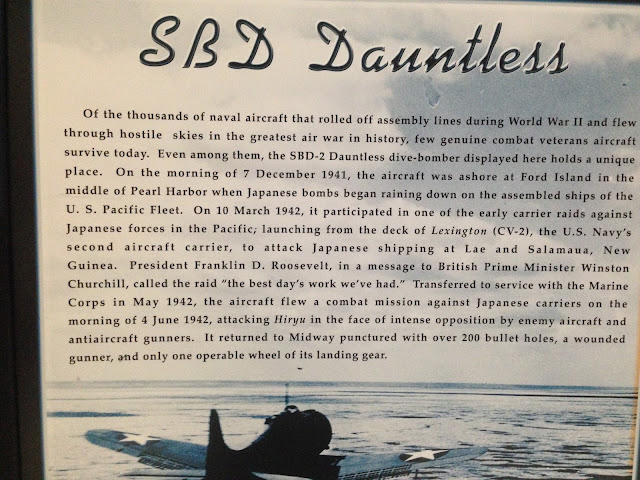Yes, sir, this is one hell of
a wondrous place tucked away on Naval Air Station Pensacola. If you breeze
through this part of the Gulf Coast, don’t you dare let the pestering wife and
screaming kids make you miss one of the great military museums in the world.
Before you come in, have a short talk with the fam and mention a whole section
dedicated to the important role women have always played in aviation. For the kids, promise them sights, hands-on
exhibits and rides that take them into the wild blue with the Blue Angels.
Do you find yourself saying:
“Yeah, sure, another stack of dusty old stuff sitting around for me to stare
at. All the same to you if we just go
have a beer?”
No, you dull minded nitwit, it’s
not all the same to me. There are more tentacles
of history running through this museum than you’ve ever imagined. Important history and not just history, but heroic,
breathtaking stories that you’ve never heard. History streaked with the blood
and gritty determination of men and women who took us from wood and cloth
covered airplanes, dangerous and freakishly chancy, to air travel that’s as
necessary to the 21st Century as trains were to the 19th.
“Wait a sec,” you’re saying,
“I thought you said this was Naval Aviation!”
See, you just lack the knowledge, and it’s another reason you need to
visit a few museums. When the dream of
manned flight escaped from Orville and Wilbur’s bicycle shop in Dayton, Ohio
and took it’s first gasping breath on the sandy hills four miles south of Kitty
Hawk, North Carolina, a new world was born.
Maybe it was a new wing (pun intended) of the library. One giant lift-off for mankind. Pick your own
metaphor.
 |
| Orville Wright |
 |
| Wilbur Wright |
The reality is it’s only since
the middle of the 20th Century that aviation really untangled itself
and spawned Army Aviation, Naval Aviation, Air Force Aviation, Commercial
Aviation, and General Aviation. In the
beginning, there was only aviation, period.
Yes, yes, I know a stickler will claim the aviation branches came along
much earlier. Ok, you’re right, but
Jimmy Doolittle’s 1942 attack on the Japanese mainland was Army B-25 bombers
lifting off from a Navy carrier. And who provided the Intelligence? A naval officer.
 |
| B-25 Mitchell |
 |
| Amelia Earhart |
You’ll see flimsy craft like
the British WWI airplane the Sopwith Camel. Know how long the average British
fighter pilot lasted on the Western Front in World War I? Three weeks.
How much flying time did the lads get before going to France? 8-12 hours.
Even in World War II, we lost
over 14,000 aircraft in training accidents.
Aviation has always required courageous people.
 |
| See the bullet hole patches? |
How about the Douglas
Dauntless, the primary Naval dive bomber of World War II? You’ll learn all about it and especially the
unlikely story of the Dauntless on display. Retired Naval pilots weave through
the museum to explain and entertain and thrill and make even the seasoned
aviator stay glued to the tales of desperate heroism and miraculous survival.
It’s not just U.S. Naval
aircraft on display, also a slew of aircraft flown by the opposition: the German Fokker D-VII from WWI, Japanese
Zero and German Me-262, and Soviet MIGs.
 |
| Fokker D VII |
 |
| Me 262, one of the first jet fighters |
 |
| Korean War MIG 15 |
I could write forever, but instead check out a few photos to whet your appetite. This museum won’t just entertain, but quickly turn you into a budding aviation historian. Your kids will suddenly want to be aviators and you’ll hear your wife whisper, “Honey, is it ok if we spend the night and come back again tomorrow?”
“Yes, dear, if you
insist.” I applaud your unselfish spirit
and budding interest in aviation. High
five! I take back the part about you being
a dull minded nitwit. Now let’s go grab that beer.
 |
| P-40 Warhawk in the colors of the American Volunteer Group in China |
 |
| Ball turret from a PBY4, the Navy version of the B-24 Liberator |





No comments:
Post a Comment